Building a DIY solar setup for a Camper Van,
Quick note before we get started. This is just one part of an overarching “How to Install a DIY Camper Van Electrical System” series. If you’ve just stumbled on this article directly without seeing that, there are likely some things we’ve already covered. If you want to check out that step by step guide, you can do that here: https://www.explorist.life/diy-campervan-solar
Also, we have interactive solar wiring diagrams that are a complete, A to Z solution for teaching you exactly what parts go where, what size wires to use, fuse size recommendations, wire lug sizes, and all kind of other stuff to help save you time and frustration. You can check that out here: https://www.explorist.life/solarwiringdiagrams/
What are the Basic Parts of a Camper Solar Setup?
The basic parts of a Camper Solar Setup
- Solar Panels
- Charge Controller
- Batteries
- Inverter/Charger
- Battery Isolator
- Busbar
- Battery Monitor
- Shunt
- 12v Distribution Block
- Fuses
- Wires
- AC Breaker Box
- 110v Plug
- Shore Power Plug
- 12v Switches
- 12v Outlets.
Video: Basic Solar Parts Needed for a DIY Install

Solar Panels
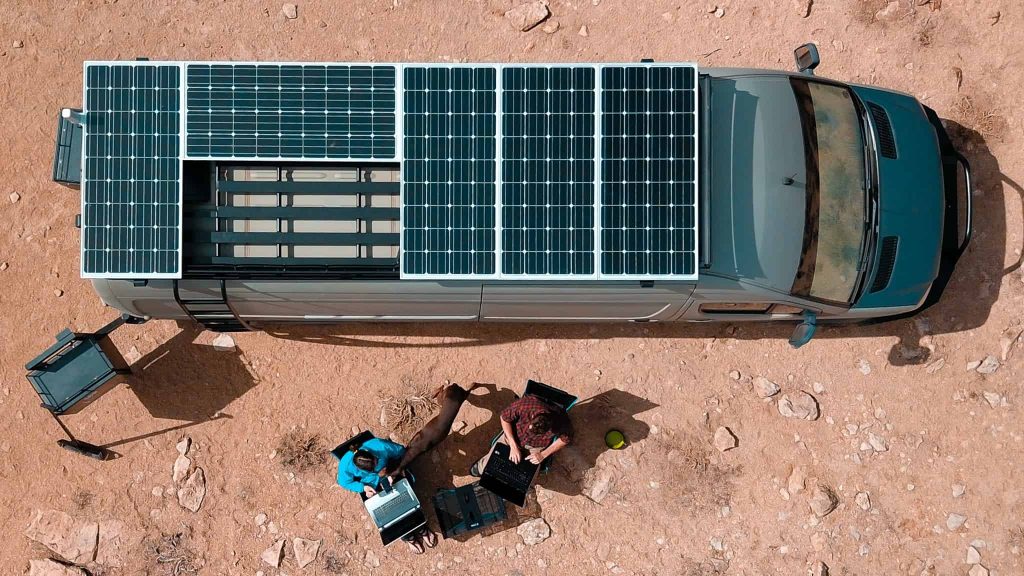
What do Solar Panels Do?
Solar panels are the most obvious component in a solar system. Their job is to gather solar energy from the sun and send it down the wires to the solar controller.
What are the two types of Solar Panels?
There are two main types of solar panels. They are Monocrystalline and Polycrystalline, and the MAIN difference between the two is their efficiency.
Monocrystalline vs Polycrystalline Solar Panels
Take these two solar panels from the same company for example. The first one is the Polycrystalline and the 2nd one is the Monocrystalline.
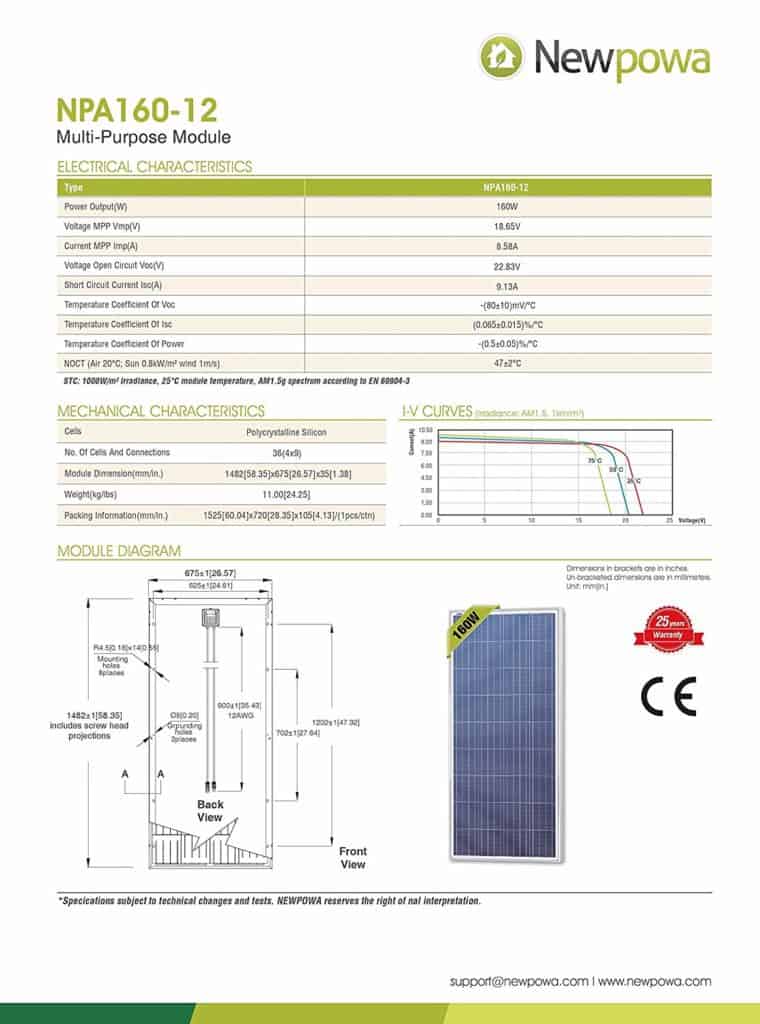
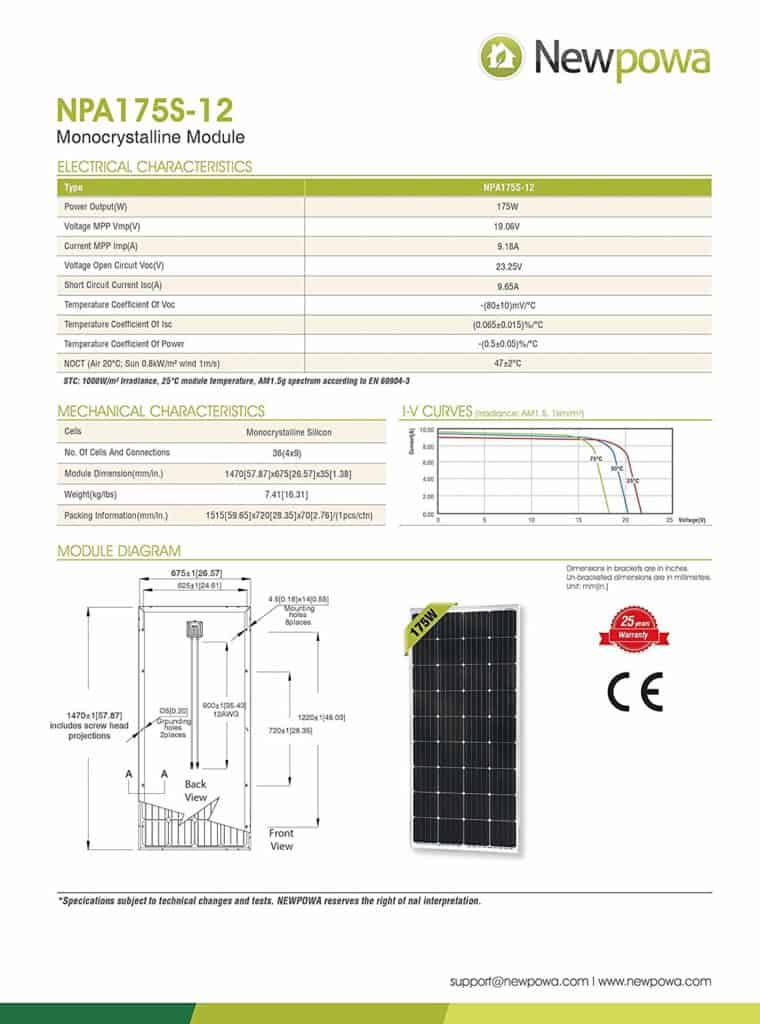
Take these two solar panels from the same company for example. The one on the left is the Polycrystalline and the one on the right is the Monocrystalline. The Polycrystalline is rated at 160 watts and has dimensions of 58″ x 26″. The Monocrystalline is rated at 175 watts and has dimensions of 57″ x 26″.
The two are within an inch in physical size, but the monocrystalline panel is capable of producing 15 more watts per panel. Which means (depending on conditions) you could be potentially gaining an extra 5-10 amps per day per panel if you opt for Monocrystalline over Polycrystalline.
Monocrystalline vs Polycrystalline in the Shade
I’ve seen articles and videos talking about how these two technologies of panels function in terms of shading or cloudy days. There have been lots of opinions given on this, but I have yet to see anything definitive and conclusive to make a blanket statement one way or the other; which leads me to believe… neither one really does a good job in the shade and, perhaps, solar panels just work better in the sunlight. Don’t overthink this.
What Solar Panels are Best for a Camper?
Since roof space on camper vans is extremely limited, go with the monocrystalline solar panels. You’ll get more power out of the same space leaving more room for vent fans and rooftop dance parties.
The Polycrystalline will also be fine if you are really trying to pinch pennies, but maybe the solar panel isn’t the place to skimp as it would be, likely, one of the more difficult components to replace on down the road.
Charge Controller
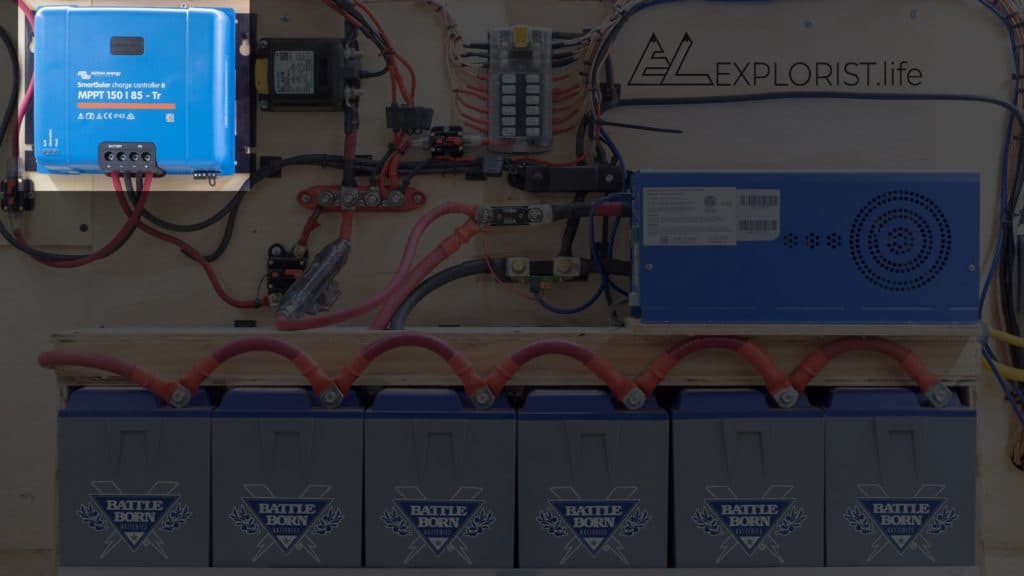
What does a Charge Controller Do?
The Charge Controller takes the solar power from the solar panels and then converts it into a form of more ‘organized’ and useful power. The power is coming from the solar panels at varying voltages. Anywhere from 16 volts to, potentially in the hundreds of volts depending on the setup. The charge controller regulates that voltage down to the 12-15 volt ballpark (if you are on a 12v battery bank) to properly charge, said battery bank.
What are the types of Charge Controllers?
There are two main types of charge controllers on the market. MPPT and PWM. Those stand for Maximum power point tracking and Pulse width Modulation.
MPPT vs PWM Charge Controllers
PWM is an older technology. Your solar panels must be within a fairly narrow set of parameters to even be compatible with a PWM controller. They are less efficient as they are, pretty much, just a regulator. The only ‘pro’ to a PWM controller is that they are less expensive.
MPPT Controllers are a newer, MUCH more sophisticated technology and have more ‘processing power’ behind them which lets them do more calculations depending on the input voltage to optimize the output voltage to the maximum amount of amps possible to be stored in the batteries for use.
Is an MPPT Controller Worth It?
The ‘buy-in’ fee is a higher, but the added flexibility and performance will give you more bang for your buck in the long run. Get the MPPT controller. Unless you are strapped for cash… then… save up, and get the MPPT charge controller.
Batteries
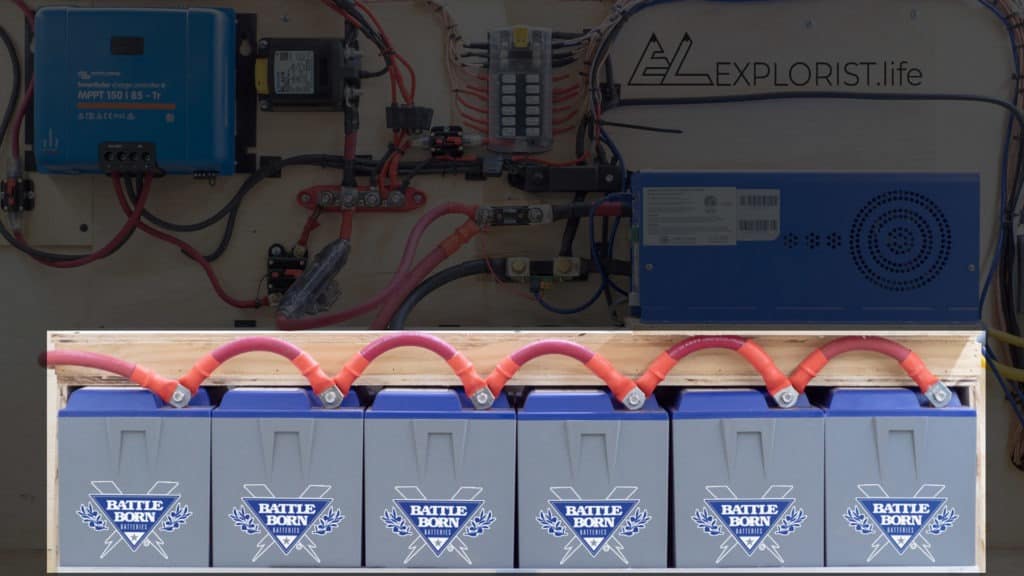
What do Solar Batteries Do?
Batteries are simply ‘storage tanks’ for power. They store the power that the solar panels and charge controllerhave made until it’s ready to be used to run computers, charge phones, brew coffee…or whatever.
What are the Main Types of Solar Batteries?
There are three main types of batteries on the solar market. Lead Acid, AGM, and Lithium.
Lead Acid vs AGM vs Lithium for Camper Solar
Lead Acid
These require maintenance and they vent corrosive hydrogen gas. They were the standard for a while, but then technology caught up. Although they can work in some setups, IMO, they are generally more hassle than they’re worth.
AGM & Lithium
AGM & Lithium are the two more commonly used types of batteries in campers currently. Lithium batteries are significantly more expensive up front, but they are cheaper over the long run. Related: AGM vs Lithium – A cost-benefit analysis
What’s the Best Battery for a Camper Van?
Go with lithium. It’s lighter, more powerful, bigger bang for your buck in the long run. But, here’s my Recommendation if you can’t afford Lithium: Go with the …BUT!!… Get the SIZE of AGM battery that you can switch out to lithium in the future if you happen to change your mind.
To Clarify, a Battle Born Lithium Battery is about 12 ¾ x 7 x 9 inches and a Renogy AGM battery is 13 x 7 x 9 inches (so, nearly identical). If you’re living for the moment and need to go with AGM batteries now, you can buy, say, 3 of the AGM batteries now. Once they wear out, or you need more capacity. You can swap in 3 lithium batteries directly in their place, bolt them up, change a few parameters on your charge controller, and you’ll be good to go. Effectively tripling your capacity with the same battery footprint.
Plan for the upgrade now, and it’ll make the upgrade less expensive and easier when it’s time.
Inverter/Charger
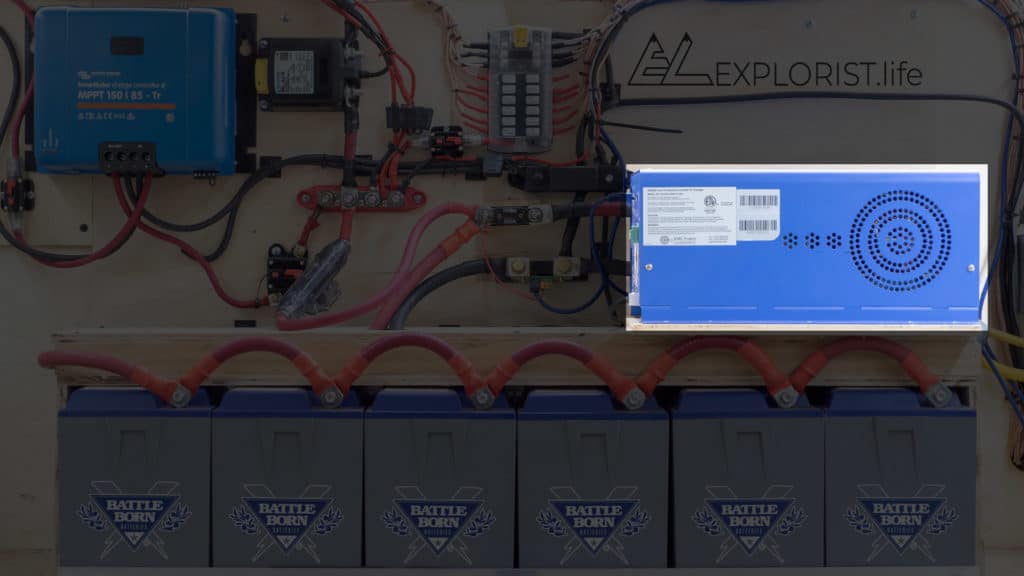
What is an Inverter Charger?
Inverter/Charger combo units are, pretty much just that, an inverter and a charger all wrapped up into one nice and neat package.
What does an Inverter Do?
Your battery bank stores power at 12 volts. If you have something, say, a coffee maker or an instant pot… you will need 110 volts a.k.a. A normal household plug. The inverter takes the 12v power stored in the batteries and converts it into 110v power so you can power those household appliances.
What are the Different Types of Inverters?
Inverters come in a few different types. Square Wave, Modified Sine Wave, and Pure Sine Wave.
What kind of Inverter is best for a Camper?
You’ll be looking for a Pure Sine Wave Inverter. This inverter does the best job of mimicking the power that is ACTUALLY coming through a standard plug you can find in any on-the-grid wall. Square Wave and Modified Sine Wave aren’t recommended, because, the power they ‘Make’ isn’t a ‘clean’ power and can damage certain electronics and I can’t recommend those because I don’t like recommending products that have an inherent risk of damaging other equipment.
What size of Inverter do I need for my Camper?
Pure Sine Inverters come in sizes from small and portable 300w models all the way up to… a lot. To get by with “Modest Usage” like running a coffee pot, Instant pot, or induction stove, the most common size I’ve seen AND the size we have in OUR campervan is a 2000w inverter, but if you want to learn, in more detail, how to accurately size an inverter for YOUR setup, you should click here to learn more.
Charger
What is Shore Power?
This is how you can charge your batteries via ‘shore power’: Which is a campground power pedestal or even – simply a plug-in at someone’s house. Shore power is simply an external plugin… somewhere on the grid. There’s not too much to say about these. You can get these in a separate unit, but typically, it’s easier and cheaper to just get the all-in-one inverter/charger combo package. They charge your batteries at a rapid rate. Anywhere from 40-70 amps DC.
Do I need an Inverter for my Camper?
For anybody looking for the comforts of home, an inverter is a MUST. If your rig is JUST for the random weekend outing… Perhaps run a 12v refrigerator and charge cameras, drones, and such; perhaps you can go without. You really just have to ask yourself ‘What do I plan on powering’ and how much like ‘home’ do I want this to feel.
Battery Isolator
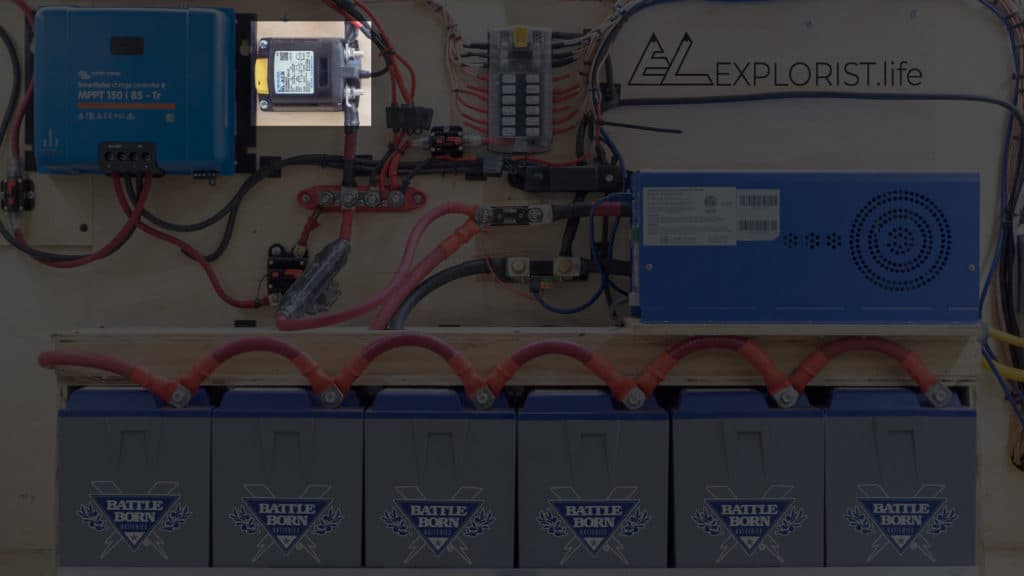
What is a Battery Isolator in a Camper Van?
This is the device that lets you charge your solar battery bank with the engine alternator. It let’s power pass when the engine is running and it closes when its engine is off so you don’t drain your starting battery as you use your solar batteries.
That’s ‘basically’ how it works, but to learn the picky details of installation and what systems you can use it with, there’s more to know…
Busbar
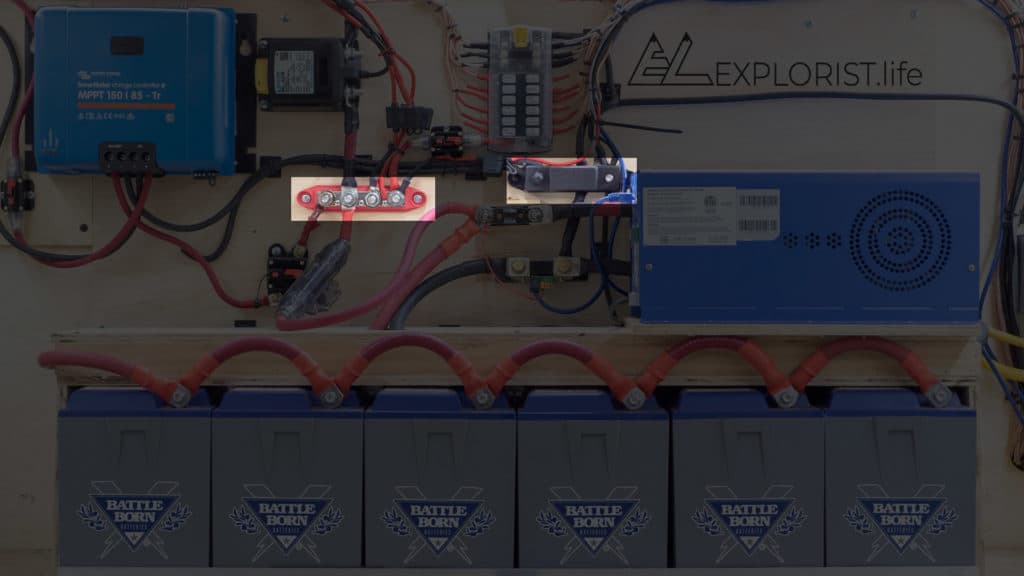
What is a Busbar?
The Busbar is an extension of your battery terminals. When we’ve got a dozen different wires and components that need to be connected to the battery ‘directly’, the top of the battery terminal can turn into a giant birdsnest of wires in a hurry. These just give you a little more room to work with your wiring AND make it easier to see exactly what you’ve got going on and what wires are going to where.
Battery Monitor
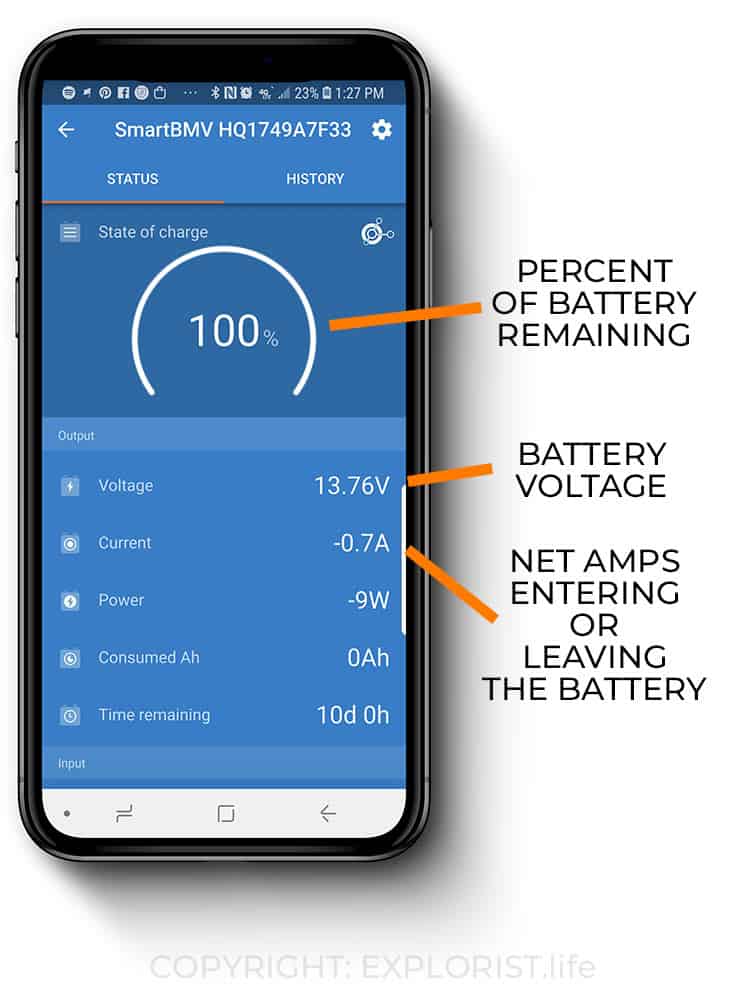
What is a Solar Battery Monitor?
The battery monitor tells you the status of your batteries. Like, their capacity, voltage, and how much power is ACTIVELY being generated or lost. The monitor is able to tell us this information by the information provided by the shunt.
Shunt
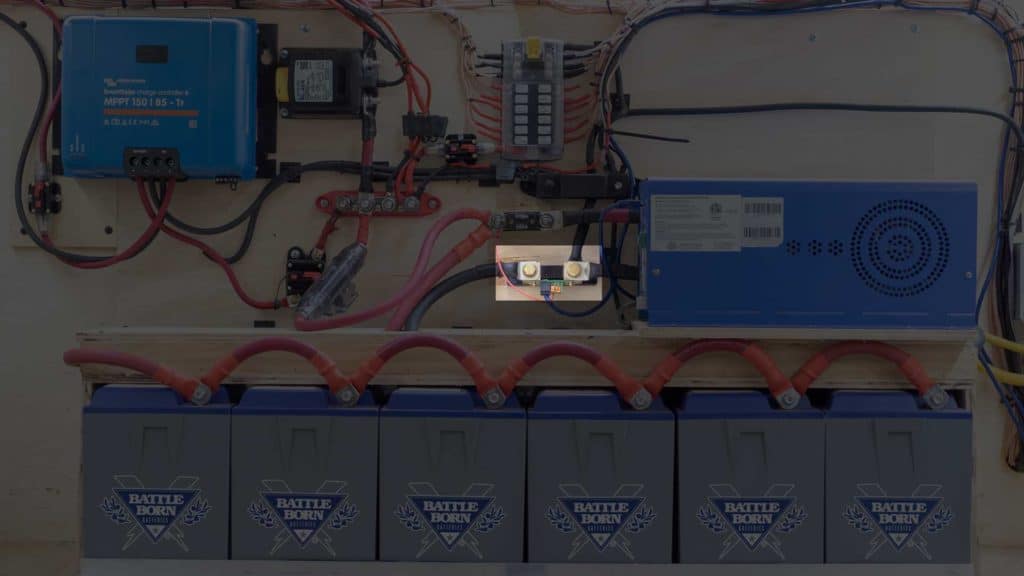
What is a Shunt?
The shunt is physically responsible for ‘counting’ the amps that are either coming or going in either direction and reporting that to the battery monitor. If the Battery Monitor is the brain, the Shunt is the body. The Shunt sits in line of the negative battery terminal and the bus bar. ALL loads should be on side of the shunt that’s away from the battery.
These are typically included with the battery monitor
12v Distribution Block (Fuse Block)
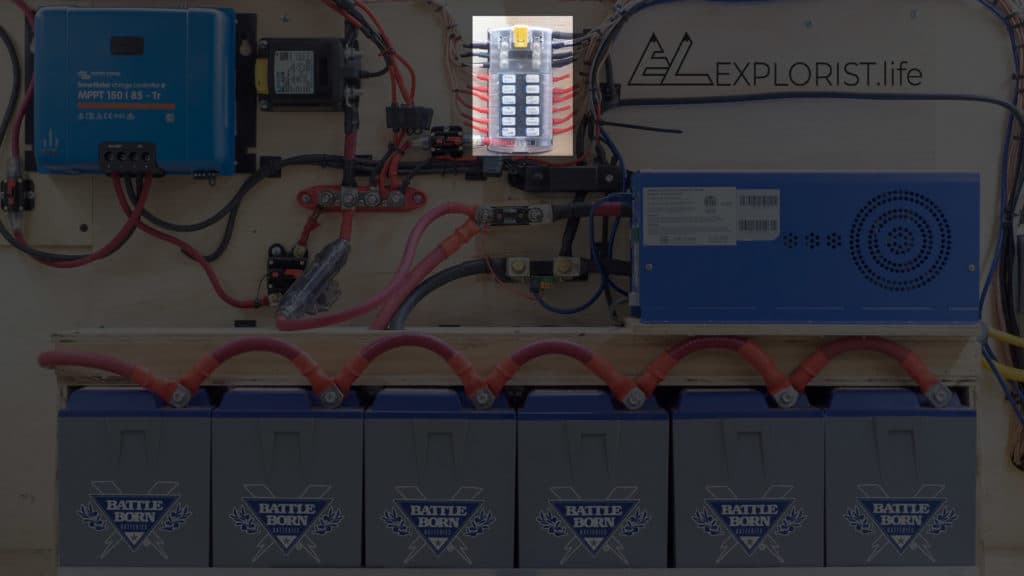
What is a 12v Fused Power Distribution Block?
This fuse block is the easiest way to make fused connections to those low amperage devices and keep everything safe, tidy and organized. This is how you will run all of your wires to your accessories like lights, fans, 12v outlets, 12v refrigerator, USB ports, etc.
Fuses
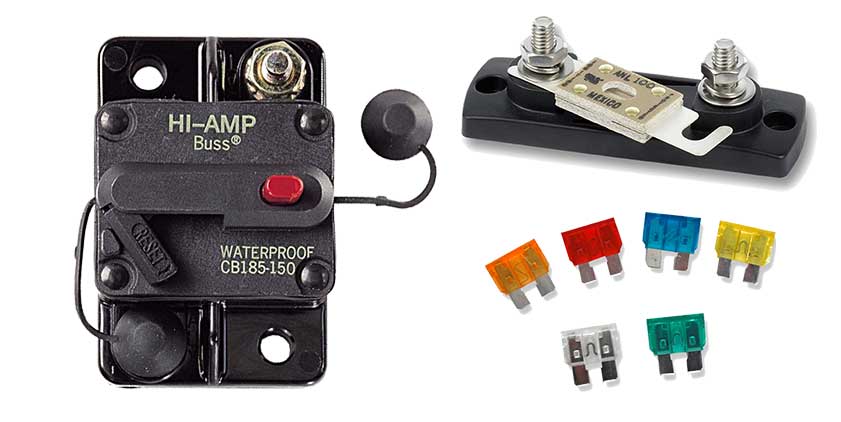
What is a Fuse?
Fuses are what protect your wires in case of an over-current situation a.k.a. a malfunction. If there are too many amps flowing through too small of a wire (or if something is malfunctioning), the wire can melt and possibly start a fire. The fuse is designed to ‘blow’ or ‘trip’ at a current lower than that point which will cut the flow of power, effectively shutting off the hazard.
What are the Different Types of Fuses?
There are 3 types of DC fuses I find myself using.
- Spade Fuses
- Resettable Breakers
- ANL Fuses
The type of fuse I pick varies on how it’s being used, the current going through it and the size of wire it’s attached to.
Wires

What do Wires do in a Solar Setup?
Wires transport power from one component to the next. The come in various sizes. “Small wire” for use on lights and fans would be somewhere in the 12-18 gauge realm
What is Wire Gauge?
Gauge is the measurement unit for wires. There’s a more technical way to explain it, but we don’t need to. It’s just like inches, centimeters, miles, or whatever. It’s fairly relative. Just know that 12-18 gauge is pretty small
Oh, and the higher the number goes, the smaller the wire is.
BUT
Once you get into BIG wire for carrying BIG currents like required by the inverter, it gets tricky. As the wire gets bigger, the gauges go 8, 6, 4, 2, 0, 1/0, 2/0, 3/0, 4/0.
AC Breaker Box
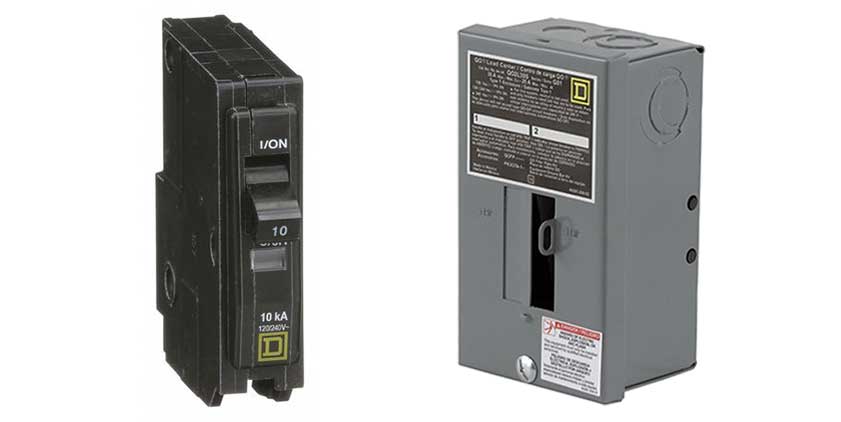
What is an AC Breaker box in a Camper Solar Setup?
The AC breaker breaks the flow of electricity to an AC (alternating current) circuit to protect the wire from melting.
Do I need an AC Breaker Box in my Camper Solar System?
Depending on the inverter/charger you get, it may or may not come with an AC breaker installed. If not, and you are wanting to hard wire 110v plugs throughout your camper, you will need to add an AC breaker.
You will need the breaker box, as well as a breaker to protect the wiring and 110v circuits.
110v Plug
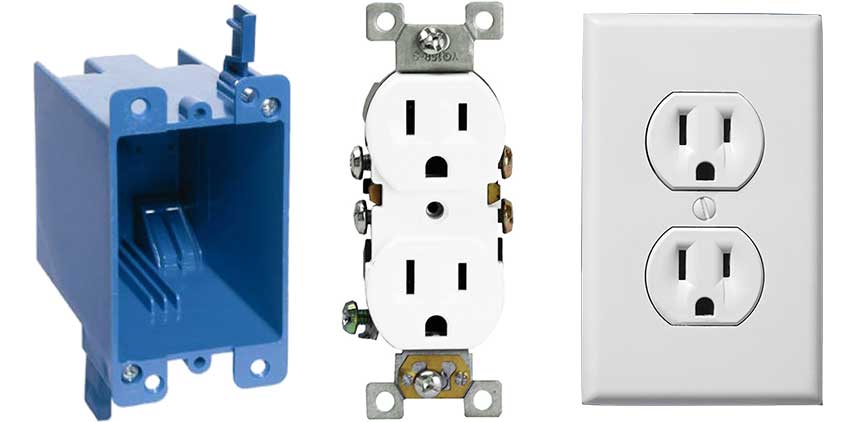
What is a 110v Plug?
It’s the household 110v plug and the box you install it into. Sometimes, people use the plugin that’s commonly found on their inverter to plug in directly. This plug and box is for if you want to have 110v plugs throughout your camper build.
Shore Power Plug
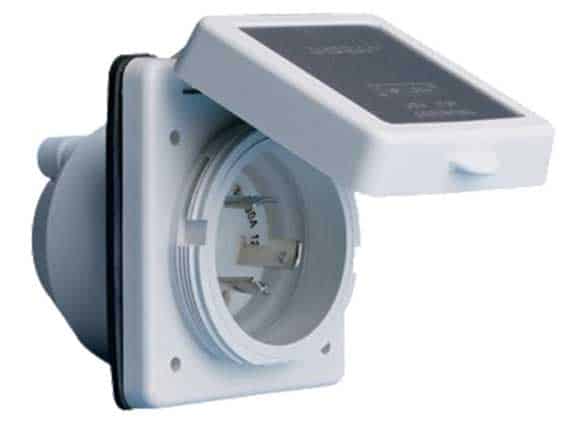
How do I add Shore Power to my Camper Van?
Add an exterior power port onto your camper so you can plug in directly into the van. It looks a little less sketchy than slamming the extension cord between the door and the door jam.
You can get a 30a plug, or a 15a plug.
I’d recommend a 30a plug if you are planning running an air conditioner… or you just never want to have to question anything regarding shore power capacity.
12v Switches

What is a 12v Switch?
These break the power going to lights, fans, outlets or whatever you are trying to control. If you get a REALLY big swtich, you can kill power to your entire system (which is a nice feature to have…)
12v Outlets
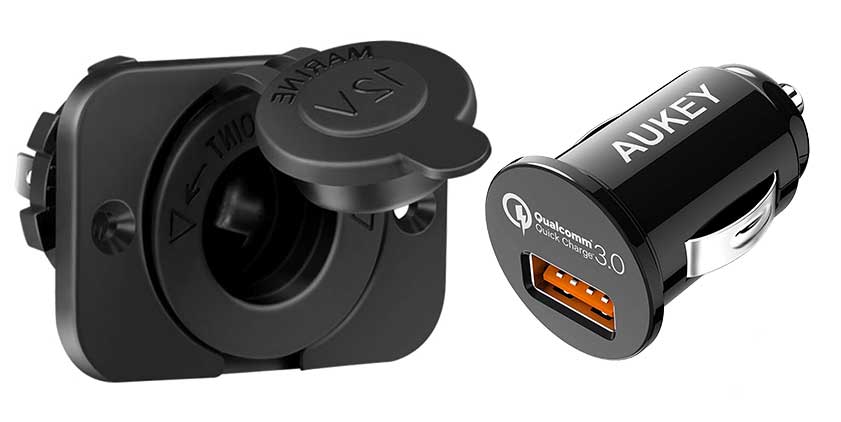
What is a 12v Outlet?
This is where you can plug in USB adapters, computer chargers, small inverters or led Christmas lights for some sweet #vanlife Instagram pictures.
12v Outlet vs USB Outlet for Camper Van
Something to consider: On Amazon, a lot of these 12v outlets may come with a USB plug pre-installed in it. I don’t like that because USB Technology changes every single year. They are always coming out with faster ways to charge our devices. My recommendation? Don’t install hard-wired USB outlets. Install 12v outlets and have flush mount USB adapters on hand. This is INFINITELY more versatile if you are trying to future proof your build.
Keep Learning:
Now that you’ve learned about the individual components of a camper van electrical setup, the next thing I’d recommend is learning how much battery capacity you’ll need in your camper van electrical system. Check that out here: https://www.explorist.life/what-size-of-solar-system-is-needed-to-power-a-camper/
Everything that you are learning here is put to use in our FREE Interactive Solar Wiring Diagrams. If you haven’t yet, check them out as they are a complete solution for a camper van electrical system. Check them out here: https://www.explorist.life/solarwiringdiagrams/
Remember, this is just one part of a full camper van electrical educational series. To see all of the individual guides, click here: https://www.explorist.life/diy-campervan-solar
Finally, If you found this guide helpful, It’d truly mean the world to us if you’d share it with somebody who can use it, pin it to pinterest for later reference, or share it to a facebook group when somebody has a question about this subject. Click the bubble in the lower right corner to subscribe to be notified of future updates and as always, leave any questions you’ve got in the comments below.
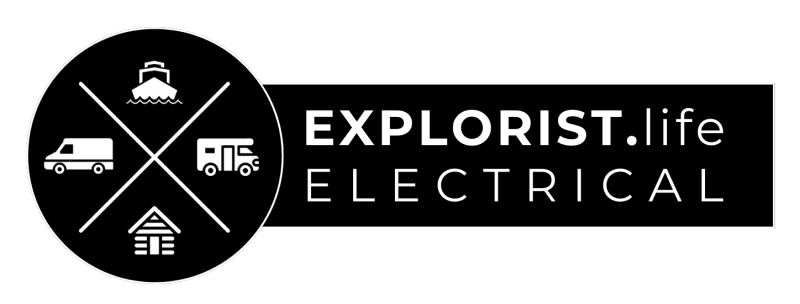
63 Responses
Does anyone know if there’s a good reason to swap out my old solar isolator which is Nate’s older breaker box idea for one of the solar isolators? Wondering if the solar isolator might be smaller.
The solar isolator is not smaller, no. If you have the older breaker in place and wired up correctly and it’s not giving you issues, there is no reason to replace.
Hi Nate. Thanks for the use of your Power Audit Spreadsheet! It took some time, yet worked flawlessly. This being said, our power needs are short footprint on the top of the campervan. We will mostly be off grid without access to shore power, and may eliminate shore power completely. Can we over compensate our battery storage for the shortcoming of solar power? Is it worth it with DC-DC mostly? Looking at your Camper Wiring Diagram 2000w INVERTER | 200-400Ah Lithium | 200 TO 700W SOLAR. Any thing we would need to beef-up to add 200Ah more?
I would never recommend a system without shore power. Shore power is absolutely necessary in a well-built system, if for nothing else, troubleshooting and commissioning the system as it is a ‘guaranteed’ source of power.
Hey thanks for all the info.but for the moment i need to go on minimals (euros).so my question is…if i jave a lighter battery charger conect to a 90A battery chargin while i drive for the moment i need to suply a 12v friezer box a 12v water pomp and a coffie machine 700watts.can i use a small inverter? Is that ok just for some weekends? Thank you and grettings from holland
With properly sized fuses, wires, and components, you can indeed design your own system. Unfortunately there is not enough info in your question for me to vouch for your plan as-is.
Glad to have discovered this treasure trove.. thank you Explorist Life. We havejust started.. learning.. to add DIY goodies to a MB GL450 4matic.
Cool! Glad you found us! 🙂
Just purchased a used truck pop up. We want to go 100% electrical as we are not comfortable with gas. All research I have attempted to find always talks about off the grid. We do not plan on ANY off the grid, other than an occasional parking on the street because the campground was full. So with that I have been finding it difficult to determine needs. I will check out battery capacity above. We are only 11ft by 6ft to heat or cool, so your articles are a god send.
Thank you, will be signing up and intend to read everything you have
Great! Glad it’s helped.
Great info. I am handy enough with household electrical and this gives me a great jumping off point to learn about mobile solar. So looking forward to pouring through everything your site has to offer. Thanks so much for putting this out there.
Great! Glad it helped!
Appreciate the post. Very informative. We want to outfit our Hike camper and would love to have a rough cost estimate for a moderate sized system including all things you mention. The dealer gave us a price of $6,000.00+ for 2 lithium batteries and an all inclusive 2000 watt inverter,labor etc. No solar panels. Seems high based on what we’ve read. Could you share your thoughts?
Sure! I have a diagram and shopping list that you can check out and start pricing out all of the bits and pieces that you would need. This would give you an accurate cost of what It would cost to DIY a system like that: https://www.explorist.life/2000w-inverter-200-400ah-lithium-200-to-700w-solar-camper-wiring-diagram/
As far as if the installer is too expensive… I have no clue. I teach people how to do this stuff themselves, so I am not in-tune with what an installer would charge.
The BlueSea systems ML-ACR 7422 (?) relay that you’re using in the photo is not compatible with LiFeP04 batteries. It will never turn on/off at the correct times and the batteries will not fully charge. I have the same relay, and have spent several months tracking that down to be a problem with the system. I’ve verified this with BlueSea, and there is no way to reprogram it for lithium voltage cutoffs, and there is no replacement from BlueSea. The options I’ve seen are Victron Cyrix or the Batter Isolation Mangager (BIM) sold by Battleborn.
Yes. That is correct. That particular device is indeed, not compatible with Lithium as the voltage set points for when it connects/disconnects are too low. I covered this a bit more in depth here: https://www.explorist.life/how-to-charge-diy-camper-van-batteries-with-vehicle-alternator/
Invaluable resource here!
Question, my van has a built-in 115v, 100w inverter with a standard US 2-prong Household outlet that only operates when the van is running. Seems easy enough to connect it straight to an AGM battery to charge it while I’m driving, but are there any considerations, like running it through a control first? Or does it make more sense just to charge the battery off the 12v DC cigarette lighter outlets that also only work when the vehicle is on?
If you could find a battery charger that is under 100w; you could, indeed, go that route. But the ‘more correct’ way to charge the house battery bank is by using a DC-DC charger like shown in this diagram: https://www.explorist.life/3000w-inverter-400-600ah-400-to-1200w-solar-camper-solar-kit
This post is extremely helpful! Perhaps I am missing it, but how did you configure the charge settings on the Victron Inverter Charger? Some sites say you need a computer, others say you can do it from the device….
Thanks for all the great material!
If it came from Battle Born, they USUALLY change the charge parameters in-house before sending it out. If you want to change the settings yourself, you can dive into the manual to decode the DIP switches or you can program via computer by way of the MK3 – USB adapter: https://amzn.to/3hm1kcv
I inherited a rudimentary solar set up that I’m updating/changing.
My question is that I have 2 RV/marine starting/cycling batteries in this system and I have no idea, what the amp hours would be.
The information on the batteries are: CCA 650 @ 0F, CA 810 @ 32F and 23 amp ave. 175 min.
This set up just runs a few lights and an RV water pump. Can you tell me what the amp hours are on these batteries and if I should keep them or replace them?
Starting batteries don’t ‘really’ have amp hours. They are made to be used and high rates for very short periods of time so they don’t have the same metrics of batteries that are designed to run low loads for long periods of time.
Thank you so much, this post was really helpful in getting me ready for what I will need in my upcoming build! The side by side comparisons really have me a good direction to go in
Hi, I’m starting to design and install a system in our 5thwheel. My goal is to have about 600watts of solar panels and a 1000 watts capacity battery bank. I want to use as much of the existing electrical system is possble.
Already bought a MPP Inverter/charger which includes the solar controler and automatic transfer switch. I’m building a battery bank out of Headway 38120 8amp/hours 200amp capacity cells wired in series and parallel to buid a 24v system.
Can you point me to your video that would help me the most.
Sounds like a cool project! I think this video will be the most helpful as it may give you some ideas on connecting into your existing electrical system: https://www.youtube.com/watch?v=Ht1kl37pJ2E&list=PLmvhcyi4n0TU6HlMaQiCUwC20DBlyv6s_&index=10&t=4s
I love the write-up. I am currently designing a system for my MB Sprinter 144″ 2WD. I am building my own roof rack. Should be done this weekend fingers crossed.
I am going to be running two of the zamp solar 90 watt long panels and a single 80 watt panel in front of them. I found them on sale at (link deleted). They said the panels would have cosmetic blems. I just got them yesterday and can’t see where the blem is. Super stoked.
My question is this… I do a lot of winter camping. Do you think it would be worth it to create a system to lift the panels up at an angle for better efficiency? I have seen others do it but noticed all of your panels are fixed.
Either way. Our initial plan was to have them able to tilt but Aluminess built our rack incorrectly and was a month late on delivery making our initial plan much more difficult.
I’ve read hundreds of articles in the past month while researching….if only I had found this one first! This answers so many of my original questions, truly a thorough walkthrough of some basic must-knows. Thanks for the excellent content!
Looked into a lot of information on solar setups and am an engineer myself – I have to note that our presentation of facts and know how is easy to follow and understandable
thank you for your efforts
Great! Glad it helped! 🙂
Nate, I am buying a trailer from WeeRoll that is already rigged out for AC (2 plugs) and 15v shore plugin. Do I tie into that somehow or just keep my solar separate? And if I do keep separate how do I charge my batteries through shore power? Thanks.
This video may help: https://www.youtube.com/watch?v=Ht1kl37pJ2E&list=PLmvhcyi4n0TU6HlMaQiCUwC20DBlyv6s_&index=11&t=3s
Nate, you have gone to a lot of effort to help the not so informed. I take what a salesman tells me with a pinch of salt. Your information and knowledge has helped me so much. Again, Thank You.
Great! Glad it’s helped! 🙂
Great job. Thanks
Thanks! 🙂
Hello! I’m learning a lot in your blog thank you for the useful info!
I have a question, will I need an extra battery monitor using the smartsolar charge controller? Or can I just use the smart phone?
Thank you
They are different. The Smartsolar charge controller measures different metrics than the BMV, but they work in conjunction with each other and IMO, both are VERY nice to have.
Thanks for breaking it all down like that. Love the new design of the site. I was curious how you connect wall outlets to the inverter. I was just going to run an extension cord/wall outlet but it looks like you have a more traditional box and outlet. Thanks again!
I’ll be doing a video over this soon. If you’re subscribed here, you’ll be notified when it goes live.
This name
Victron MultiPlus Compact 12/2000/80-50 120V VE.Bus Inverter Charger
Has the word bus in it- does that mean it has built in busbars?
Also I read the product description for this device at the manufacturers site and I still can’t tell if it includes a built in 110 v circuit breaker?
the VE.Bus is not a busbar. That’s referring to something different. It also does not have built in 110v breakers.
Hi Nate, really appreciate all you do for us diy’s.
My question is on lithium battery’s and how they perform in cold temperatures? Not sure if I should use AGM or Lithium. Planning on doing some part time winter camping and chasing powder at ski resorts. I don’t plan on heating the van all day while skiing but just at night when sleeping with my wabasco d2 heater.
Thanks for your time, best Dave
Thanks! Lithium batteries won’t charge below freezing, but AGM batteries will have severely decreased capacity when they are below freezing. Point is: batteries like moderate temperatures, so try your hardest to keep your batteries in the climate controlled portion of your camper.
Really great article. Simple and very informative.
Thank you.
This entire solar panel thing is blowing my mind lol what size solar panel and how many ah battery do I need to run just a maxxair fan?
Hey Christina! I’d HIGHLY recommend you start here to do a power audit and determine how much power you’ll be using on a daily basis: https://www.explorist.life/what-size-of-solar-system-is-needed-to-power-a-camper/
I would like to have the option of plugging in a remote solar panel when I am parked in the shade. Where would I wire the remote panel to (through a remote plug mounted to the outside), do I tie it in to the permeant solar panels wiring or directly to the solar controller? Thanks
You should wire a 2nd charge controller into your system that would be dedicated to the external, portable panels.
I’m planning on buying a Jayco Eagle HT Fifth Wheel 28.5RSTS and I want to add solar. Is it possible to add enough solar power to run the AC?
How many watts of panels can you fit on your roof?
How many hours per day do you want to be able to run your air conditioner?
Hello Nate
i am looking in to a solar setup and gathering materials for a bus conversion.
i would like my solar panels to be portable. meaning i can move them around when needed. i will not be full time. do you have any portable Solar panel recommendations. thank you for the great diagram and materials list.
Hey Michelle! To be totally honest, any panel can be a portable panel if you don’t mount it. Fabbing up some basic lean-to legs on the back of a panel is pretty straight forward with a bit of ingenuity. That being said, any of the panels we recommend are the same ones we’d use for a portable recommendation.
Just saying hello and would like to also say what a great job you’ve done. Thank you.
P.s. if you’re ever in mammoth skiing drop me an email. Or hiking in the summer.( maybe not this summer with all the snow though.
I’ll have a lot of comments/questions to your great work. Will this submit of comments enable me to comment/question?
Of course!
I need to applaud you for your efforts. The value you provide to the DIY Vanlifers with your videos and website is priceless. The professionalism of interactive diagrams is amazing, too. I have never subscribed to any YouTube channel, but you may be my first. You’re a cut above with your content. I’m hoping to follow in your footsteps and build a ski, surf, and race car tow vehicle on the Transit platform. When the stars align for me to get started, I plan to purchase your diagrams in support of your Vanlife. Thank you. -Andrew
Hey, awesome! Thanks for all of the kind words, Andrew!
Hey there we just started RVing and we have a solar set up and I was wondering if you’d be able to help us? I watch your YouTube and we set up our solar system and we aren’t able to have one night with full charge ? we have 400 watts of solar panels a 3000w inverter and 300 ah lithium ion batteries and we have been plugged into shoe power from almost a week with everyday fully sunny so I just figured maybe you would be willing to help us understand what we are doing wrong? Or any info at all would help us. Thank you so muh for your videos! Hope to hear from you.
Darn! I’d be first reaching out to tech support from the manufacturers/distributers of your components as I don’t have enough info on your system to help diagnose, but you’re looking for a phone call from me, you can always book a 1 on 1 consultation with me here and I could attempt to help the best I could: https://www.explorist.life/consulting
Great post and video! Thanks so much!
Best video I’ve seen thank you so much I learned quite a bit from it, I am setting up 2019 hummingbird Jayco 19 foot I will be needing help again.
Awesome! Glad it helped!